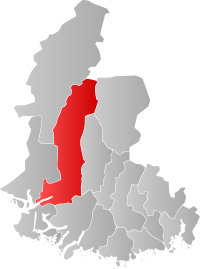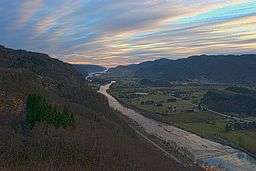Kvinesdal
| Kvinesdal kommune | |||
|---|---|---|---|
| Municipality | |||
|
View of the Kvinesdal valley | |||
| |||
 Kvinesdal within Vest-Agder | |||
| Coordinates: 58°20′17″N 07°01′23″E / 58.33806°N 7.02306°ECoordinates: 58°20′17″N 07°01′23″E / 58.33806°N 7.02306°E | |||
| Country | Norway | ||
| County | Vest-Agder | ||
| District | Lister | ||
| Administrative centre | Liknes | ||
| Government | |||
| • Mayor (2015) | Per Sverre Kvinlaug (KrF) | ||
| Area | |||
| • Total | 962.42 km2 (371.59 sq mi) | ||
| • Land | 886.47 km2 (342.27 sq mi) | ||
| • Water | 75.95 km2 (29.32 sq mi) | ||
| Area rank | 110 in Norway | ||
| Population (2016) | |||
| • Total | 5,981 | ||
| • Rank | 176 in Norway | ||
| • Density | 6.7/km2 (17/sq mi) | ||
| • Change (10 years) | 7.5 % | ||
| Demonym(s) | Kvindøl[1] | ||
| Time zone | CET (UTC+1) | ||
| • Summer (DST) | CEST (UTC+2) | ||
| ISO 3166 code | NO-1037 | ||
| Official language form | Neutral | ||
| Website |
www | ||
|
| |||
Kvinesdal is a municipality in Vest-Agder county, Norway. It is located in the traditional district of Lister. The administrative centre of the municipality is the village of Liknes. Other villages in Kvinesdal include Feda, Fjotland, Knaben, and Storekvina.
Kvinesdal is an elongated mountain-to-coast municipality, reaching saltwater at the head of the Fedafjorden, which provides access to the North Sea in the south. Further north, the landscape is cut by narrow valleys with scattered small villages. There are also abandoned mines at Knaben, a popular ski resort. Because Kvinesdal resembles the geography of the nation as a whole, it is often referred to as "Little Norway".[2]
Kvinesdal belongs to a central area in the Norwegian south from which many people emigrated to North America, particularly the United States, from the 1850s until the 1950s. It is noted for being an "American village" (Norwegian: Amerika-bygd) because of the high number of American residents. These are typically either Norwegians who moved to the States, obtained US Citizenship and later moved back to Norway, or are descendants of Norwegians who have never acquired Norwegian citizenship.
General information
.jpg)
The parish of Kvinesdal was established as a municipality on 1 January 1838 (see formannskapsdistrikt). In 1841, the neighboring municipality of Fjotland (population: 980) was merged with Kvinesdal to form a new, larger municipality of Kvinesdal, although this was short-lived. In 1858, the merger was un-done and Fjotland became a separate municipality once again. After the split, Kvinesdal had 4,485 residents.
On 1 January 1900, the municipality of Kvinesdal was divided into two: the municipality of Feda in the far southern part (population: 1,090) and the municipality of Liknes in the northern part (population: 2,937). The name of Liknes municipality was changed (back) to Kvinesdal in 1917. During the 1960s, there were many municipal mergers across Norway due to the work of the Schei Committee. On 1 January 1963, the municipalities of Fjotland (population: 1,244), Feda (population: 576), and Kvinesdal (population: 3,218) were merged to form one large municipality of Kvinesdal.[3]
Name
The Old Norse form of the name was Hvínisdalr. The first element is the genitive case of the fjord name Hvínir (now called the Fedafjorden) and the last element is dalr which means "valley" or "dale". The name of the fjord is derived from the river name Hvín (now Kvina), and that name is derived from the verb hvína which means "squeal". During the period from 1900–1917, the municipality was named Liknes.[4]
Coat-of-arms
The coat-of-arms is from modern times; they were granted on 15 March 1985. The arms show a Y-shaped silver or white figure on a blue background. The Y-shape symbolizes the meeting of the two rivers: Kvina and Litleåna which join together and then flow into the Fedafjorden just south of Liknes.[5]
Churches
The Church of Norway has three parishes (sokn) within the municipality of Kvinesdal. It is part of the Lister deanery in the Diocese of Agder og Telemark.
| Parish (Sokn) | Church Name | Location of the Church | Year Built |
|---|---|---|---|
| Feda | Feda Church | Feda | 1802 |
| Fjotland | Fjotland Church | Fjotland | 1836 |
| Netlandsnes Chapel | Netland | 1886 | |
| Kvinesdal | Kvinesdal Church | Liknes | 1837 |
Geography
The long, narrow municipality of Kvinesdal stretches from the mountains in the north, along the Kvinesdalen valley to the Fedafjorden in the south. To the west, Kvinesdal is bordered by Flekkefjord and Sirdal municipalities. To the east, it is bordered by Åseral and Hægebostad. To the south, it is bordered by Lyngdal, and it is bordered by Farsund in the east and south. A small segment of the northern boundary borders Bygland municipality in Aust-Agder county.
The river Kvina, which runs through the municipality, is known for its salmon, and salmon fishing is a popular activity.
Two valleys meet in Kvinesdal's center: Vesterdalen (the Western Valley) through which flows the river Kvina and Austerdalen (the Eastern Valley) through which flows the river Litleåna to join the Kvina.
Climate
| Climate data for Liknes | |||||||||||||
|---|---|---|---|---|---|---|---|---|---|---|---|---|---|
| Month | Jan | Feb | Mar | Apr | May | Jun | Jul | Aug | Sep | Oct | Nov | Dec | Year |
| Daily mean °C (°F) | −2.0 (28.4) |
−2.0 (28.4) |
1.0 (33.8) |
4.5 (40.1) |
10.1 (50.2) |
13.7 (56.7) |
15.2 (59.4) |
14.7 (58.5) |
10.7 (51.3) |
7.4 (45.3) |
2.5 (36.5) |
−1.5 (29.3) |
6.2 (43.2) |
| Average precipitation mm (inches) | 180 (7.09) |
130 (5.12) |
135 (5.31) |
85 (3.35) |
105 (4.13) |
100 (3.94) |
115 (4.53) |
150 (5.91) |
205 (8.07) |
240 (9.45) |
240 (9.45) |
200 (7.87) |
1,885 (74.21) |
| Average precipitation days (≥ 1 mm) | 16.6 | 11.1 | 12.8 | 10.4 | 11.7 | 10.9 | 11.0 | 12.3 | 15.8 | 16.6 | 17.9 | 16.9 | 164 |
| Source: Norwegian Meteorological Institute[6] | |||||||||||||
Population
About 10% of the inhabitants of Kvinesdal are American citizens, and Kvinesdal does enjoy a special relationship with the United States. Every year, the municipality hosts a special festival remembering the days when local people emigrated to the new world.
History

Kvinesdal was home of many prominent characters in the Saga Period. Among them were the Skald Tjodolv the Frode. Frode means one with great knowledge of the history of ancestors. He composed a historic poem for his king Harold Fairhair. His work was later combined into the Heimskringla when it was recorded by Snorri Sturluson.
In northern Kvinesdal, along the high plateau which sits at 550 metres (1,800 ft) above sea level, records show that the Salmeli Farm dates back at least to the year 1300. During the Black Death years of 1350 the farm became deserted, but was back as a working farm again by 1647. It is now a historic site.
The bailiff Stig Bagge, who was granted local leadership from 1536-1542 by Christian III of Denmark, was an energetic man when he lived at his ancestral home of Eikeland in Kvinesdal. According to the reports of Peder Claussøn Friis, he executed refractory peasants so willingly that the district thought it was to excess; he was the district's bogeyman for many years thereafter. When the bailiff in Nedenes was killed in his bed and rebels came in an unsuccessful attempt to capture and execute Stig, he collected his men and brutally stifled the revolt. Stig himself died by being drawn and quartered by the Dutch when he was caught in piracy or espionage off their coast at Walcheren.[7]
Government
All municipalities in Norway, including Kvinesdal, are responsible for primary education (through 10th grade), outpatient health services, senior citizen services, unemployment and other social services, zoning, economic development, and municipal roads. The municipality is governed by a municipal council of elected representatives, which in turn elect a mayor.
Municipal council
The municipal council (Kommunestyre) of Kvinesdal is made up of 27 representatives that are elected to every four years. Currently, the party breakdown is as follows:[8]
| Party Name | Name in Norwegian | Number of representatives | |
|---|---|---|---|
| Labour Party | Arbeiderpartiet | 9 | |
| Progress Party | Fremskrittspartiet | 5 | |
| Conservative Party | Høyre | 5 | |
| Christian Democratic Party | Kristelig Folkeparti | 5 | |
| Green Party | Miljøpartiet De Grønne | 1 | |
| Centre Party | Senterpartiet | 2 | |
| Total number of members: | 27 | ||
Economy
In addition to various small businesses and public services, Kvinesdal's economy is driven in part by hydroelectric power. The Sira-Kvina power company derives hydroelectric power from the Kvina river, in addition to various smaller dams. Eramet is an important local employer that provides work to about 200 persons in producing manganese-alloys.[9] There is also a small tourism industry, with golfing and fishing being the main draws.
Notable residents
- Aril Edvardsen, a world-renowned Christian charismatic evangelist and the founder of Troens Bevis Verdens Evangelisering (English: Evidence of Faith World Evangelisation). The organization has its headquarters in Kvinesdal, called Sarons Dal (English: The Valley of Saron), with a giant mess hall, offices, music studio, TV-studio, a small congregation called Kirken i Dalen (English: The Church in the Valley), a theological seminary, camping sites and swimming pools.
- Kristian Marcelius Førland (1891–1978), one of Southern Norway's greatest artists, lived and painted in Kvinesdal. His home is now a museum.
- European Rallycross Champions Ludvig Hunsbedt and Guttorm Lindefjell
- The Band Luxus Leverpostei
- The footballers Atle Roar Håland, Tor Henning Hamre and Roger Eskeland
- Social scientist and journalist Andreas Hompland
- Graphic Designer Liv Denmark
See also
References
- ↑ "Navn på steder og personer: Innbyggjarnamn" (in Norwegian). Språkrådet. Retrieved 2015-12-01.
- ↑ Welle-Strand, Erling (1996). Adventure Roads in Norway. Nortrabooks. ISBN 82-90103-71-9.
- ↑ Jukvam, Dag (1999). "Historisk oversikt over endringer i kommune- og fylkesinndelingen" (PDF) (in Norwegian). Statistisk sentralbyrå.
- ↑ Store norske leksikon. "Kvinesdal" (in Norwegian). Retrieved 2016-09-23.
- ↑ "Civic heraldry of Norway - Norske Kommunevåpen". Heraldry of the World. Retrieved 2016-09-13.
- ↑ "eKlima Web Portal". Norwegian Meteorological Institute.
- ↑ Stagg, Frank Noel (1958). South Norway. George Allen & Unwin, Ltd.
- ↑ "Table: 04813: Members of the local councils, by party/electoral list at the Municipal Council election (M)" (in Norwegian). Statistics Norway. 2015.
- ↑ "Eramet Norway Kvinesdal". Eramet Norway.
External links
| Wikimedia Commons has media related to Kvinesdal. |
| Look up Kvinesdal in Wiktionary, the free dictionary. |
 Vest-Agder travel guide from Wikivoyage
Vest-Agder travel guide from Wikivoyage- Kvinesdal Guest House and Hotel (Norwegian)
- Official website of Kvinesdal (Norwegian)
- Webcam from Kvinesdal
- Tourist Information
- Kvinesdal Golf Club
- Kvinesdal Rock Festival
- Kvinesdaladressen - din egen @kvinesedal.co addresse!



